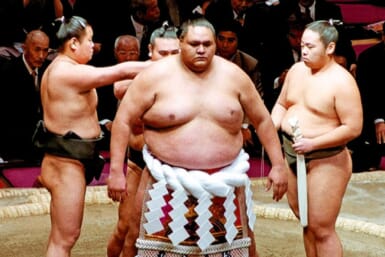by Jeff Libengood
What a year. No, what a decade! Chances are, most of us have never experienced such a decade like the ’90s. How many of us heard the words “Internet” or “email” 10 years ago? Now some of us cannot function without them. Also, do I need to say more than, keitai denwa? We saw feast and famine in the Japanese economy. How about the L.A., Hanshin, Turkish and Taiwan earthquakes!? Or, the sarin gas attacks, collapsing securities companies and banks? The whole time, technology is moving along at a frantic pace. In 1969 we landed on the moon. But, 1999 saw Mars as a rendezvous point! Heck, the newer version of my top-of-the-line laptop I purchased four months ago has been released…twice!
With the world hustling at this pace (and for what, really?) we are perplexed with far busier lifestyles and increased stress levels manifesting themselves as mental and physical problems.
Personally, 1999 saw marriage to my lovely wife, Maria, and as we enter the new Millennium, February will realize the launching of my Perfect Performance & Conditioning Center. It will set the standards for corrective exercise, strength and conditioning, weight loss and rehabilitation in Japan.
The best and most rewarding life is a balanced one. A wise man knows when to work hard and when to rest and realize what is truly valuable. Being overly busy often lends itself to neglecting oneself (and loved ones). Neglect can manifest itself as mental stress, psychosomatic pain, excess body fat, deconditioned musculature, low back pain, joint pain, headaches, trigger points, nervousness, insomnia and a host of other ailments. The aim of this article is to supply information, tips and to get you thinking.
There is no “isolation” in the body. The “three-loop theory” by Arat addresses the “spill over” effect of the hormonal (also motivates every aspect of the nervous system), musculoskeletal and limbic systems. (The limbic system plays an integral role in emotions, motor control and learning as well as dealing with biological drives such as feeding, drinking and reproduction.)
I.e., a person crashes on his bicycle. There’s a massive influx to the musculoskeletal system, soaring it to 100%. Fight or flight is also experienced in the hormonal and limbic systems. There is simultaneous activation of all three and one spills over into the other two. Research by Arat indicates the first two muscles affected by an over-loaded limbic system are the levator scapula and upper trapezius. The mechanics of your cervical spine and shoulder are married through the levator scapula. Ever heard of “kata kori“? Head aches? Trigger points? Hyper tonicity? Here’s one reason!
Science shows exercise facilitates learning. I believe the type of exercise becomes a key factor in accessing more mentally (getting your brain working more) and further challenging oneself physically to achieve more from the workout. In other words, the mind and the body are linked and both can be maximally involved in your workouts…or minimally. The body has two reflex systems, tilting and righting. Maintaining balance over a stable surface requires the tilting reflexes. But to keep balance over an unstable surface, such as a Swiss Ball or moving escalator, becomes the responsibility of the righting reflexes. The latter requires far more participation of the brain, neural system and using more muscles in more ways.
“Use it or lose it” definitely applies to the body. I know a dozen cases of knee pain cured simply from starting the proper exercise program. It also applies to the mind. The cerebellum is responsible for fine motor control. Because of its comparator function (analyzing what the brain wants, the spinal generators send and the peripheral system experiences) it assists with postural and dynamic control. If you don’t challenge it, it weakens. Nerves send impulses to contract muscles. A strong impulse, along with other factors, means a strong contraction. When you subject the body to unstable and challenging stimuli, you recruit far more neural and muscular work, thereby increasing contractile capacities.
Females, (I have a special “Women and Weights” article coming out) you have 10 times less testosterone, 10% less muscle mass and 10% more body fat on the average than your male counterparts. Females have less muscle to fulfill workout requirements so work capacity and recovery are different. Females’ cells respond differently to diet and exercise than a man’s. Females present more joint laxity than males and on the average and have greater Q-angles (measured through knee joints from wider hips), which relate to postural considerations and exercise selection. Do not do any more than 10% of your total workout with machines. Learn the intricacies of female training.
Don’ts for everyone are:
- Don’t do lat machine pulldowns and military presses behind the neck. This promotes forward head posture and places too much torque stress on the anterior shoulder capsule and medial elbow.
- Don’t spend more than 10% of your routine in machines. (They operate from a fixed axis of motion, thereby are not optimal for you. They force the brain to shut off all postural muscles, thereby training you to have a nervous system like a salamander.)
- Don’t squat in a Smith Machine!
- Don’t start your training with abdominals.
- Don’t bounce while you stretch (bouncing activates the stretch/reflex causing contraction which can result in microtrauma to tissues by forcing the joint beyond its normal range of motion.)
- Don’t consume carbs (pasta, bread, noodles, potatoes, rice) past 4 p.m. if you want to lose fat.
- Don’t try to spot reduce. There is no such thing.
Do’s are:
- Correct postural faults before beginning any conditioning program.
- Workout with Swiss Balls, medicine balls and powerballs. They have countless uses and provide tremendous workouts while hitting the nervous system hard.
- Incorporate conditioning drills, “big bang” and compound exercises, and plyometrics for weight loss and strength & conditioning.
- Perfect and exercise using the seven primal movement patterns.
- Learn how to condition your “core” properly.
Now, you have a lot of ammunition and plenty to think about. If you have a trainer, have him/her update your program to challenge you and achieve more. Also, you are invited to attend my seminars (call for schedule) or contact me with questions. I wish you much happiness and balance in the new millennium. Together in purpose…








